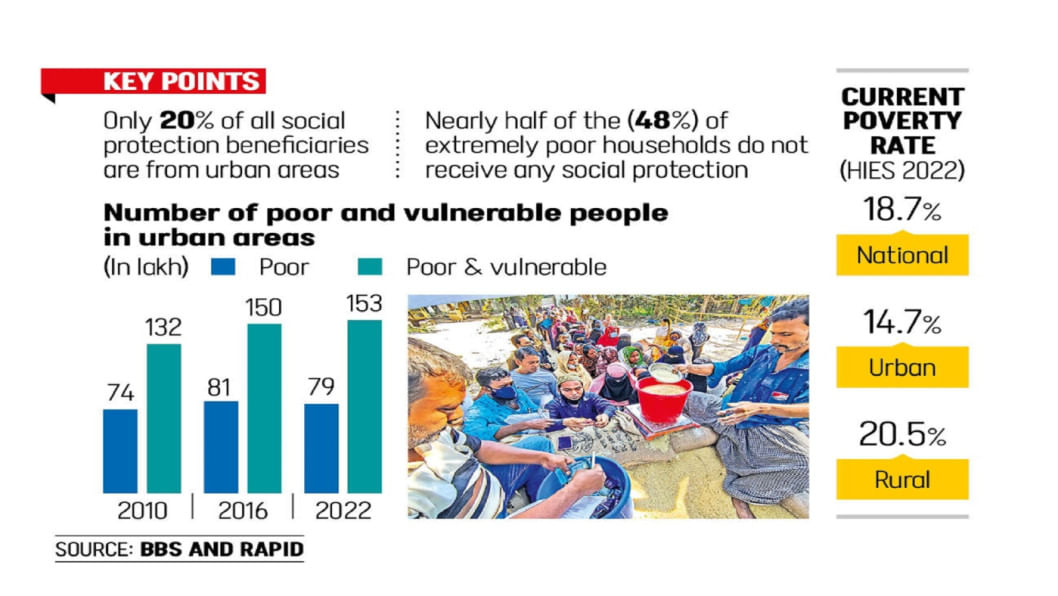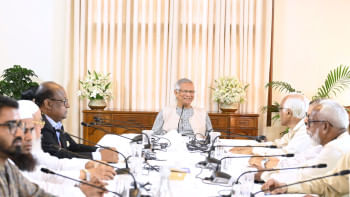Urban poor largely left out of social protection

Even though urban poverty and vulnerability continue to rise, towns and cities account for only one-fifth of the total beneficiaries of government social protection schemes, according to a paper presented at a national conference on social protection yesterday.
Besides, nearly half of extremely poor households in the country receive no social protection benefits. The exclusion rate for extremely poor households in urban areas is nearly 64 percent, much higher than the national average.
"This leaves the urban poor and vulnerable groups underrepresented in the safety net schemes," said Mohammad Abdur Razzaque, chairman of Research and Policy Integration for Development (RAPID), presenting the paper at the National Social Protection Conference at the Bangladesh-China Friendship Conference Centre in Dhaka.
The Cabinet Division and the General Economics Division hosted the event with assistance from Australian Aid and UNDP.
Razzaque said Bangladesh's social protection programmes remain heavily rural-focused despite rapid urbanisation and the continuous influx of people into cities.
For instance, education stipends at both the primary and secondary levels overwhelmingly benefit rural households. The same is true for allowances targeting widows, deserted women, persons with disabilities, and elderly citizens. In most of these schemes, more than 80 percent of recipients are rural, he added.
The exceptions are pensions for retired government employees and allowances for freedom fighters, where urban households have a larger share compared to other programmes. Even then, rural beneficiaries remain significant, he said.
"Historically, social safety nets in Bangladesh were originally designed to reduce rural poverty, hunger, and vulnerability stemming from natural disasters. However, with growing challenges of joblessness, housing insecurity, and rising living costs in cities, the lack of urban-focused safety nets is increasingly seen as a policy gap."
Razzaque said there are about 23 schemes specifically designed for the urban poor, but they accounted for just 4 percent of the total social protection budget in the last fiscal year.
In comparison, about 50 programmes designed for rural areas only accounted for 27 percent of the total social protection budget. The rest of the schemes cover both rural and urban areas.
A substantial share of poor and vulnerable households remains entirely excluded from social protection programmes, he said.
"The poverty impact of social protection is low due to the lower level of benefits and targeting errors," said Razzaque, urging the government to take effective steps to eliminate the errors.
Mohammad Khaled Hasan, additional secretary of the Cabinet Division, said the government is planning several steps to include the urban poor under social safety net coverage.
At the event, Md Rezaul Maksud Jahedi, secretary of the Local Government Division, said, "We have 560 urban centres, including 330 municipalities and city corporations.
The population in these areas is increasing every day. People are moving to cities after being hit by various natural disasters and river erosion."
As a result, ensuring health and sanitation for slum dwellers in cities has become very complex, he added.
"We are currently spending about $1 billion annually to ensure social protection, health, and environmental security in these centres. Yet, our actual need is $7 to $8 billion. We also have plans to work for the urban poor."

 For all latest news, follow The Daily Star's Google News channel.
For all latest news, follow The Daily Star's Google News channel. 



Comments